When we purchased the house it came with a nice, deep pond that was perfect for waterlilies. It also came with an upper pond with a waterfall into the lily pond, and two other small ponds. Two decades later, one of the small ponds has now been converted into a planter, and another into my bog garden. Remaining are the two largest ponds, the lily pond and the upper pond, which we reduced in size by half.
We’ve had waterlilies blooming since the end of April. I have no idea what variety this one is–It came with the pond that came with the house. But it’s a tough and reliable plant.
The ponds are mostly John’s territory, but I’ve sneaked a couple California native species into them. The first is a cattail (Typha sp.), one of my favorite water plants.
If you’ve ever grown these, you realize quickly that there’s a certain amount of maintenance that goes with them, mainly in dealing with their spreading rhizomes. If the plant is potted, it’ll soon escape and will require frequent trimming when growing actively. Here are a couple of shoots that have escaped into the fertile pond scum. In the past the shoots got tossed, but I just read in an excerpt from Steve Brill and Evelyn Brin’s Identifying and Harvesting Edible and Medicinal Plants in Wild (and Not-So-Wild) Places how they’re totally edible and are nicknamed “Cossack’s asparagus.” The next trimmings will be going into the skillet.
A new native to the pond is California bulrush (Scirpus californicus), a replacement for a giant papyrus that finally succumbed after two decades. Although the new scirpus is called a rush, it’s actually a sedge. Two months ago it was a one-gallon plant. Now it’s easily twice the size.
Its little flowers aren’t spectacular, but a mass of these little bloom clusters could be a nice effect once it gets a little larger.
The closest canyon is about an eighth of a mile away, but various critters find their way to the water. Raccoons, opossums and tracks from a cat larger than a house cat, smaller than a cougar have been sighted over the years. During the first years a couple of visits from a great blue heron finally discouraged John from trying to raise koi in the lower pond after they ended turning in expensive birdfeed.
These days the main visitors are sparrows, which blend so well with pond scum and the surrounding rocks that they’re hard to see…
…and these days we’re seeing a lot of these lesser goldfinches.
Now that our daytime temperatures have finally been climbing into what you’d expect during the summer, I think I might be frolicking in the water if I were one of these birds.

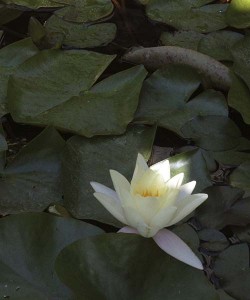
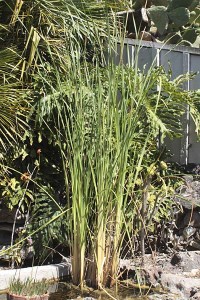
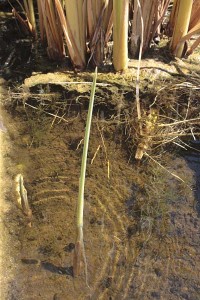
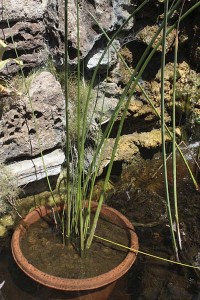
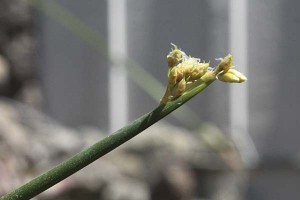

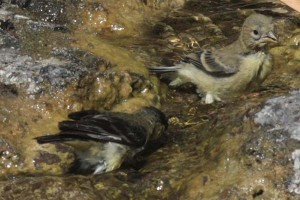
Oh, I’m envious! I would so love a big pond with frogs and dragonflies… Do you have dragonflies? I’ll be curious how the culinary experiment turns out…
Love looking at the happy birds. A good reason to have a pond, even in water starved times.
We have pond building as one of our favorite activities. Am curious what kind of pump you have, filtration and more. We put feeder goldfish and very inexpensive koi in ours, use lots of floating and submerged water plants (which furnish virtually all the food they need) create lots of hiding places and place items strategicallly to discourage cranes resting near edge. Then we let nature do the rest. So far, though the cranes eat some, the fish population is self sustaining. The first time I saw a crane near the fish, I tried to scare it off. The next time i saw him, I thought, you’re the most beautiful thing in my garden, how could I be against you? Ever since, I look at the pond and don’t worry about the birds. I just decided to paint them into the picture. Good Evening, Ed Fosgate in Orlando
Town Mouse, yes as far as dragonflies, but no for frogs. I guess the frogs have it figure out that it’s not a natural water feature and haven’t quite figured out how to burrow in the concrete banks or something like that…
Susan, it’s worth it for the birdwatching alone. Our water restrictions ban fountains but not ponds, and we’d have to be in a stage 4 state where they say we can’t have water features of any sort. (We’re in stage 2 right now.)
Ed, ponds are great and I love the sound of water. W have a pretty powerful pump (something around 40 watts or more) attached to a biological filter full of graduated sizes of stones and gravel. The water stays pretty clear. We’ve also built high patio covers over the water so that the larger pond is in shade 80% of the day. That keeps the algae down but is enough light for the lilies to bloom. I think we’ve reconciled ourselves to losing fish to the occasional bird–the population now is mainly feeder goldfish that have been spared being fed to larger fish. To discourage the mammals, we keep potted plants all around the pond edge. It’s not a great look, but it discourages raccoons that don’t want to deal with having a hard time climbing their way back out of the water. It works most of the time.
Frolicking in the water is a great past time for us all in the summer. The pond looks refreshing.
Ponds are always great. A friend’s pond has a pelican that visits to get the fish. I was shocked watching it on her roof staring into the pond. She had decided to give up on the fish because netting and other things just looked too ugly.
I also want to know how the Cossack’s asparagus turns out.